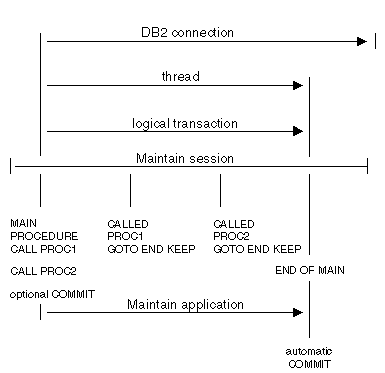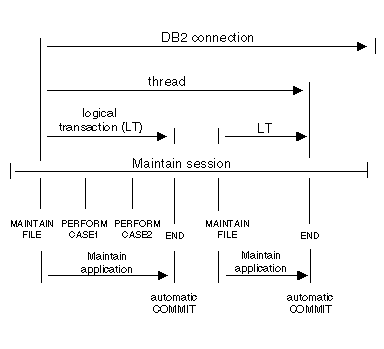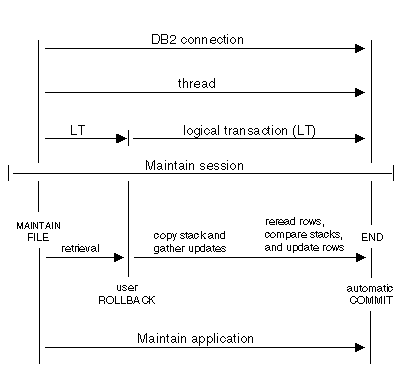Using Transaction Locking to Manage DB2 Row Locks
|
How to: |
You can use the transaction locking strategy to manage DB2 row locks in Maintain Data applications. While this strategy is described for use with DB2 data sources, you can also apply it to transactions against other kinds of data sources, changing DBMS-specific details when necessary. When using transaction locking, your application locks each row with an isolation level of repeatable read for the duration of the transaction, from the time it retrieves the row, until the time it commits or rolls back the transaction.
The following illustration shows the duration of connections, threads, and logical transactions (also known as logical units of work) when you use this strategy.

If your applications are small in scope, comprising only a single procedure, the duration of connections, threads, and logical transactions would look like the following illustration:

Compared to change verification, transaction locking is simpler to code, but keeps rows locked for a longer period of time. This may cause other users to experience time outs, in which case DB2 will return a -911 or -904 SQL code. You can mitigate the effect of row locking by:
- Keeping the size of the transaction small, making it less likely that another user will encounter a row locked by your transaction.
- Implementing the change verification strategy described in Using Change Verification to Manage DB2 Row Locks.
- Having user applications check for a locked condition when retrieving rows, and upon encountering a lock, re-issuing the retrieval request a specified number of times in a loop. If the user application exceeds the specified number of attempts, have it display a message to the user indicating that the row is in use, and suggesting that the user try again later.
- Using standard database administration techniques, such as report scheduling, tablespace management, and data warehousing.
Procedure: How to Implement Transaction Locking for DB2
To implement the transaction locking strategy for managing DB2 row locks in Maintain Data applications, bind the Data Adapter for DB2 plan with an isolation level of repeatable read. The isolation level is a Data Adapter for DB2 installation BIND PLAN parameter. In your Maintain Data application:
- Read the rows. Retrieve all required rows. Retrieval locks the rows with an isolation level of repeatable read.
- Write the transaction to the data source. Apply the updates of the transaction to the data source.
- Be sure to terminate called procedures correctly. If
a Maintain Data procedure calls another Maintain Data procedure within the
scope of a transaction, the called procedure must return control
using the GOTO END KEEP command. For more information about GOTO
END KEEP, see Designing
Transactions That Span Procedures.
Caution: If any called procedure within the scope of a transaction returns control without GOTO END KEEP, Maintain Data issues an implied COMMIT command, releasing all row locks and making the application vulnerable to updates by other users. Be sure to return control using GOTO END KEEP. Otherwise, code each transaction within a single procedure, so that the scope of each transaction does not extend beyond one procedure, or use the change verification strategy described in Using Change Verification to Manage DB2 Row Locks.
- Close the transaction. When the transaction is complete, close it by issuing a COMMIT or ROLLBACK command. The COMMIT or ROLLBACK command releases all row locks.
